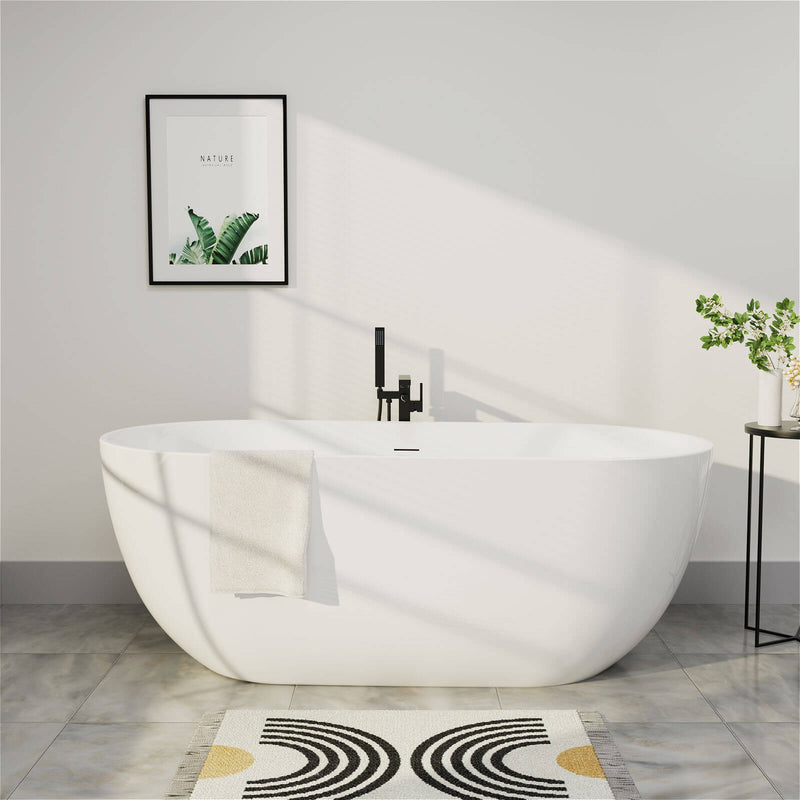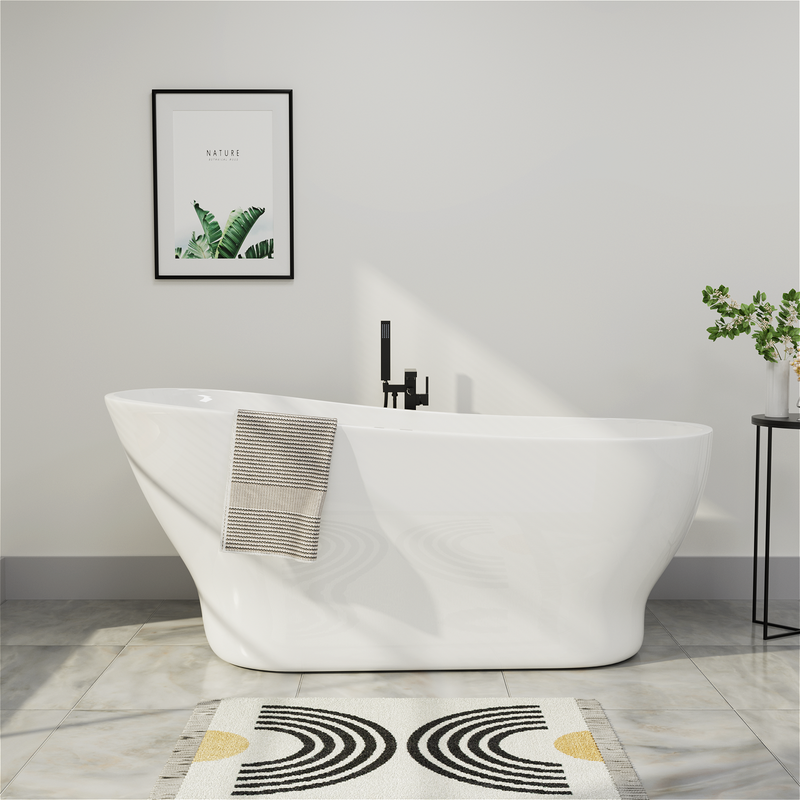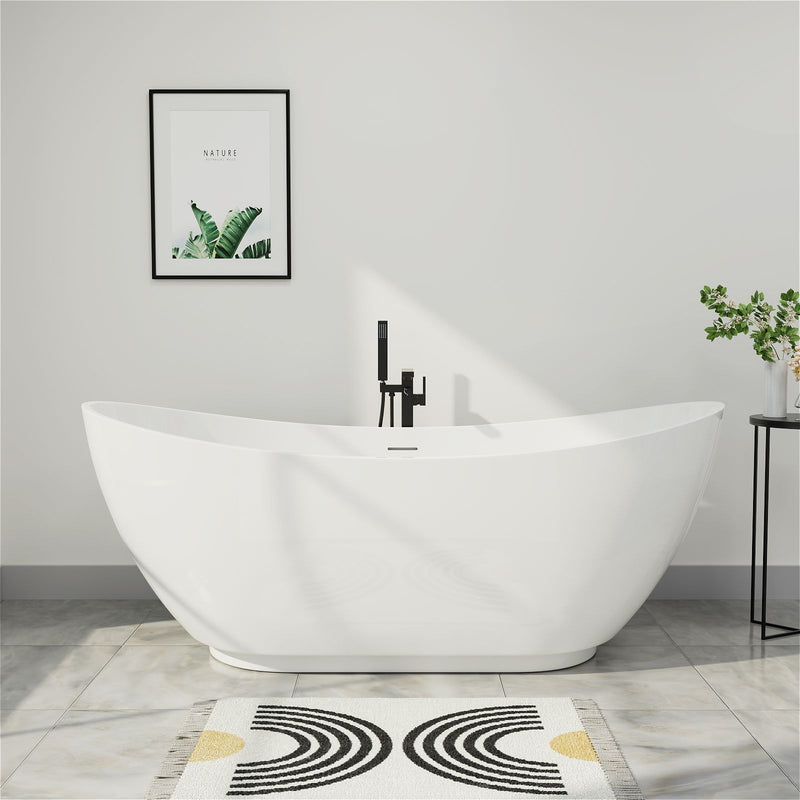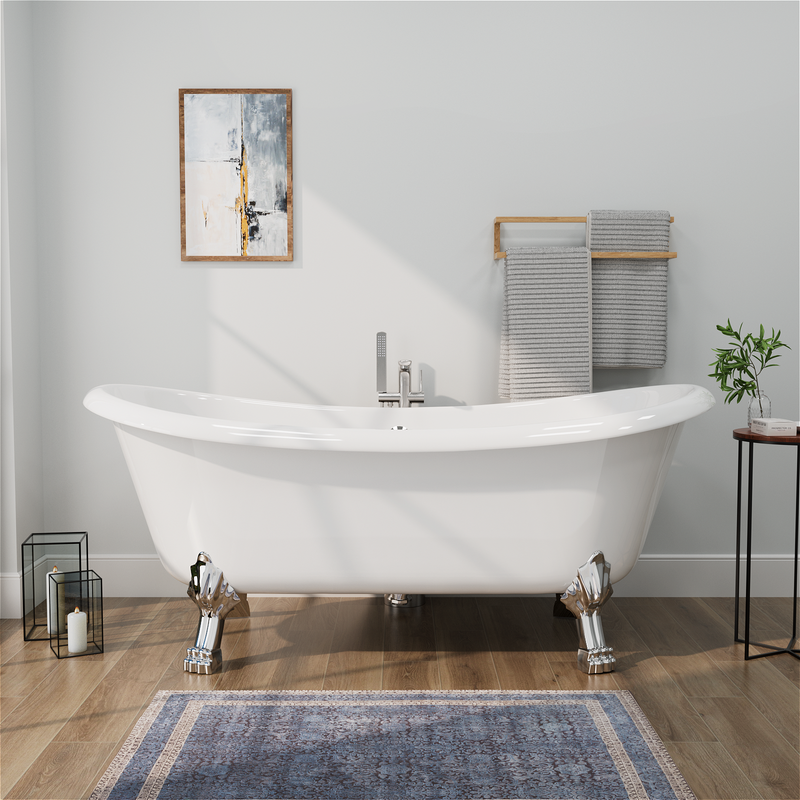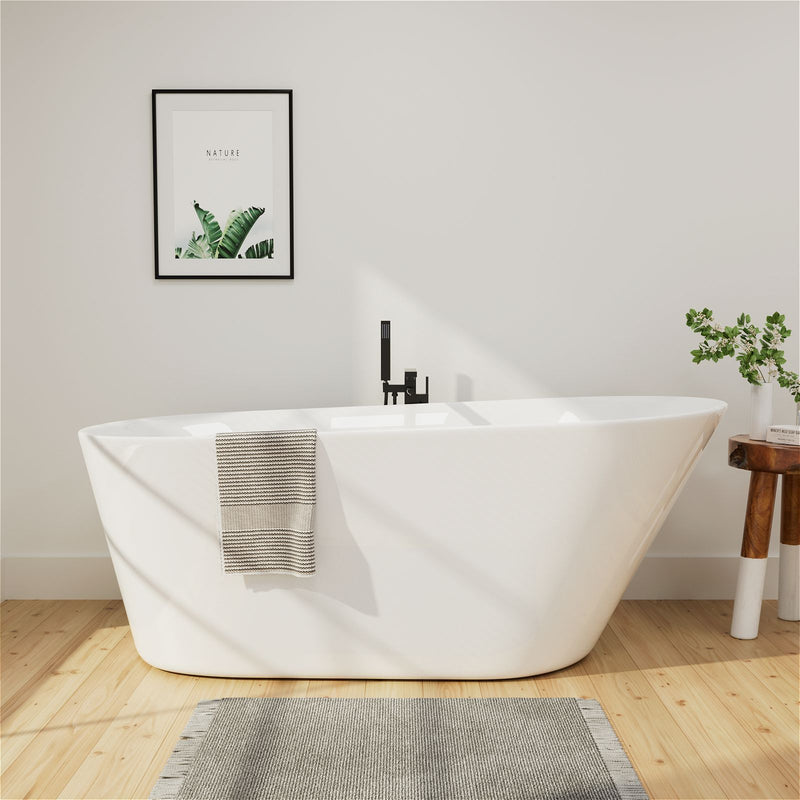Imagine the morning sun filtering through lace curtains onto a floor covered in vintage floral tiles, the air filled with the delicate fragrance of soapberries. You lazily soak in a bathtub with elegant lines and delicate legs, the warm water soothing away your fatigue. Surrounded by warm wood, soft colors, and nostalgic details - this is the uniquely soothing image of an American country-style bathroom. In this meticulously crafted sanctuary, a vintage clawfoot bathtub is more than just a bathing tool; it serves as the visual anchor of the space, encapsulating the essence of style and the unwavering protagonist in creating an ambiance of tranquility and tranquility, escaping the hustle and bustle. Chosen right, it becomes the soul of the bathroom; misplaced, it can become a stark contrast. How can you find the perfect companion in this crucial choice to truly embody the American country style? Let's explore.
Understanding the Style: What is Authentic American Country Style?
Before choosing a clawfoot bathtub, we must deeply understand the stage it serves - the essence of American country style. This is more than just a simple rustic décor; it's a romanticized interpretation of the early North American colonial era and pioneering spirit, blending pragmatism with a warm, nostalgic feel.
- Core Values: natural, comfortable, nostalgic, warm, and a handcrafted feel. Rather than luxury and complexity, it pursues a sense of intimacy, as if gently caressed by time and imbued with the essence of life. Natural materials are preferred (wood, stone, cotton, linen, and cast iron), while colors lean toward soft earth tones (cream, beige, light green, and pale blue) or warm, vintage hues. Floral, plaid, and striped patterns are common.
- Atmosphere: Soft lighting (often using blinds and lace curtains), organized storage (rattan baskets and open wooden shelves), and decorative elements with a touch of handcrafted warmth (crocheted fabrics, ceramic ornaments, and dried flowers). As a private space for relaxation, the rustic style emphasizes its tranquility, relaxation, and healing qualities.
- The Role of the Clawfoot Bathtub: Within this style context, clawfoot bathtubs, with their classic shape, historic materials (such as cast iron), and distinctive sculptural legs, perfectly embody the country style's pursuit of timeless beauty and craftsmanship. A fusion of function and artistry, their choice must be highly coordinated with the overall materials, tones, lines, and even the overall ambiance of the space.
The Design Language of Clawfoot Bathtubs: Finding Your Country Muse
Not all bathtubs with legs are compatible with the country style. The details of their design directly determine the success or failure of the style.
A Classic Silhouette Sets the Tone
- The Freestanding Style: This is the purest and most classic form of the clawfoot bathtub, freestanding from all sides, showcasing its graceful form in 360 degrees. It best embodies a vintage charm and creates a relaxed atmosphere, making it the perfect focal point for a country bathroom. Choosing this style means giving it ample breathing room to allow the eye to wander around and admire it.
- Single Slipper or Double Slipper: The bathtub wall is raised on one or both ends (single slope) to create a comfortable backrest. It's typically placed against a wall (raised with its back facing the wall). This design emphasizes comfort and a sense of envelopment during bathing, creating a more solid and stable appearance. Double slopes offer symmetry and elegance, while single slopes offer a more individual feel. This style is ideal for country-style bathtubs that prefer a bathtub that blends securely into the wall.
- Apron: One or more sides are covered by a decorative panel (apron). This design evokes a more Victorian-inspired bathroom style and can conflict with the simple, natural aesthetic of modern country style. Unless your country style leans strongly towards retro drama, a clawfoot bathtub with a large decorative apron is generally not recommended for a purely American country-style bathroom, as it can appear overly complex and heavy.
Feet: A Sculpture of the Soul
The feet of a clawfoot bathtub are the source of its name, its most distinctive feature, and a key element in its style expression. Avoid overly modern and minimalist foot styles (such as straight-line cylinders), industrial-inspired foot styles (such as metal tubular foot styles), or overly ornate and elaborate foot styles (such as gilded scrollwork Rococo foot styles).
Ideal Choices for a Pastoral Style:
- Classic Claw & Ball: This foot style mimics an animal claw (such as a lion's or eagle's claw) gripping a ball. This is the most historical and recognizable claw foot style. Choose a style with smooth, rounded lines, balanced proportions, and no overly sharp or exaggerated details. Cast iron in its original color (which can be painted later) or white finish is the most common and versatile.
- Modified Simple Claw: This style simplifies the classic claw foot with softer, more abstract lines, a more symbolic claw form, and the ball may be simplified or omitted. This style combines a vintage charm with a relaxed, modern pastoral aesthetic.
- Elegant Scroll: The foot features an elegant scroll or S-curve, similar to the legs of classic furniture. Choose a style with smooth lines, graceful curves, and minimalist detailing to create a refined and restrained pastoral aesthetic.
- Material and Finish: The legs are typically made of the same material as the bathtub (cast iron is the most common). The finish color is crucial. Pure white, soft cream, vintage cream, or matte black are the safest and most classic choices, blending well with a rustic palette. If you choose a color (such as pale green or light blue), ensure it perfectly complements the bathroom's primary or accent colors. The color should be low-saturated, preferably with a distressed feel.
Rim Lines
The lines along the bathtub's rim also influence its style. A straight, clean rim (rolled rim) is simple, elegant, and easy to clean, making it a mainstream and safe choice. A rim with a slight curve or decorative lines can add a touch of refinement, but avoid overly complex or heavy decorative lines that detract from the natural, rustic feel.
Material Selection: Tactile Feel, Warmth, and the Signs of Time
The material not only affects durability and heat retention, but also profoundly influences the bathtub's texture, weight, feel, and most importantly, its compatibility with the rustic atmosphere.
Cast Iron
Advantages
- Irreplaceable Vintage and Historical Quality: The surface is dense and smooth, and the enamel glaze is as smooth as jade. It exudes a calm and profound classic aura. It is the most authentic and soulful material for vintage clawfoot bathtubs, perfectly matching the rustic style's pursuit of a timeless feel.
- Excellent Heat Retention: Its enormous heat capacity allows it to maintain the temperature of hot water for a long time, providing a long-lasting, warm soaking experience.
- Extreme Durability: Extremely strong and wear-resistant, it has a long lifespan and can be passed down from generation to generation with proper care.
- Excellent Stability: Its heavy weight makes it extremely stable once placed and unlikely to shift.
Disadvantages
- The Weight is Incredible: this is its biggest disadvantage. Handling and installation (especially when going up stairs or through narrow passages) is a huge challenge, and the path must be accurately measured in advance and the load-bearing capacity of the floor must be assessed (especially in older houses).
- Expensive: the cost of raw materials and the manufacturing process determines its high price.
- Surfaces Need to be Cared for: good quality enamel is hard, but chipping can still be caused by hard impacts. Inferior enamel surfaces are prone to yellowing or scratching.
Acrylic
Advantages
- Lightweight: A significant advantage, easy to transport and install, and places less pressure on the floor.
- Affordable: Significantly cheaper than cast iron.
- Flexible: Easy to mold, allowing for a wider range of shapes and colors (including those that mimic the look of cast iron).
- Warm to the Touch: The material itself isn't cold, making bathing more comfortable.
- Easy to Repair: Minor scratches can be repaired with sanding.
Disadvantages
- Poor Heat Retention: Heat dissipates relatively quickly, requiring more frequent refills or the use of a bathtub cover.
- Lack of Texture and Historical Feel: No matter how realistic the surface finish, the tactile and visual weight and warmth of authentic cast iron are still far behind. It can easily appear plasticky or less classic.
- Relatively Low Durability: The surface is less hard than enameled cast iron, making it easily scratched by hard or sharp objects. It may also age and yellow with long-term use (especially with low-quality products).
- Average Stability: There may be a slight wobble after filling with water (depending on the design and internal support).
Composite Materials (Such as Fiberglass-Reinforced Resin)
Performance falls between cast iron and acrylic. They are generally stronger and slightly more heat-insulating than pure acrylic, but may also be more expensive. Their quality is also difficult to match. When choosing, focus on the texture and wear resistance of the surface coating.
Recommendations for Choosing a Rustic-style Material:
- If your budget and conditions allow, a high-quality enameled cast iron bathtub is the best choice. It offers the ultimate in style, quality, and durability.
- If your budget is limited, transportation is difficult, or the weight capacity is limited, choose a high-quality acrylic or composite bathtub. Look for:
A well-finished surface that closely mimics the color and warmth of cast iron enamel (avoid a glossy, plastic-like feel).
Feet that are well-designed and made of solid material (maybe a metal frame inside and acrylic or composite material outside), visually emulating the heaviness of cast iron feet, avoiding the flimsy, lightweight feel of plastic.
Review brand reputation and user reviews to ensure durability.
Size and Layout: Let the Bathtub Breathe Freely in a Countryside Setting
A clawfoot bathtub is the centerpiece of your bathroom. Its size and placement directly impact the comfort, flow, and style of the space.
Measure the Available Space Accurately
- It's not just about length and width! Measure the minimum clear length and width of the area where you plan to place the bathtub (accounting for any obstructions such as doors, windows, pipes, columns, toilets, and sinks). Don't forget to measure the ceiling height, especially if you plan to install a shower stand or hanging decorations.
- Allow Breathing Room: Countryside style emphasizes comfort and relaxation. Allow at least 60 cm (12 in) of clearance around the bathtub (especially freestanding models). This is not only for safety and ease of use, but also to fully showcase the bathtub's beautiful form and avoid appearing cramped. For wall-mounted models, the back and side wall space can be reduced, but sufficient space in the front is still required.
Considering the Bathtub's Dimensions
- External Dimensions: These are crucial factors in determining whether the tub can be placed properly. Clawfoot bathtubs typically take up more space than built-in tubs. Pay special attention to the total length (including the faucet position and foot extensions), maximum width (usually in the middle), and total height (from the floor to the tub rim).
- Interior Dimensions: These directly impact the bathing experience. Length determines whether you can stretch out comfortably (generally, a length of 1.5 meters or more is more comfortable), while depth determines the soaking experience (deeper tubs are more comfortable). Consider the user's height and body type.
- Foot Footprint: The foot claws will extend beyond the tub's bottom contour. When measuring, use the outermost point of the foot to determine the actual floor space.
The Art of Layout
- Freestanding: This style best showcases the tub's appeal. It can be placed in the center of the bathroom (requires ample space), by a window (to enjoy natural light), or in a corner. Ensure the tub's shape is aesthetically pleasing from all key viewing angles, and consider the compositional relationship with windows and door openings. The faucet is typically mounted directly above or to the side of one end of the tub.
- Wall-mounted: Placing the raised backrest against the wall saves space and enhances a sense of security. It is typically placed at an end wall or on a longer wall. The faucet is mounted above one end of the backrest. Ensure the backrest meets the wall properly (with sealant or decorative finish).
- View and Privacy: Consider the view from the bath (is there a view outside the window?) and privacy (door location? Are curtains or frosted glass needed?).
- Flowing Flow: The bathtub should be placed so it doesn't obstruct the main path to and from the bathroom, toilet, or sink.
Faucet Configuration: An Elegant Companion to the Bathtub
The faucet is more than just a functional component; it also serves as a decorative element that enhances the bathtub's overall aesthetic and completes the rustic style.
The Installation Method Determines Your Choice
- Floor-Mounted Faucet: A classic complement to freestanding clawfoot bathtubs. The faucet is installed directly on the floor next to the bathtub, with water flowing into the tub via a long, curved neck. This method best preserves the bathtub's discreteness and the flowing lines of its surroundings, creating a visually elegant and grand experience. It's the preferred choice for a rustic style.
- Wall-Mounted Faucet: The faucet is installed on the wall behind the bathtub. This is more suitable for clawfoot bathtubs placed against a wall (such as slipper-style bathtubs). Installation is relatively simple, but plumbing needs to be pre-buried in the wall or exposed (which can affect aesthetics). When choosing a wall-mounted faucet, ensure the height and position of the faucet spout ensures that water flows directly into the center of the tub to avoid splashing.
- Deck-Mounted Faucet: While it's theoretically possible to install on a clawfoot tub rim, this is rare and can easily disrupt the integrity of the classic silhouette, making it generally not recommended.
Faucet Style: Retro charm is key
- Cross Handles: The most iconic retro style. These cross-shaped knobs typically have one for hot and cold water, one for hot and cold water. The handles with ceramic valve cores have a warm, textured feel and are ideal for a rustic feel.
- Lever Handles: Single or double lever designs offer greater ease of operation. Choose lever styles with smooth, rounded lines and classic elements (such as a bulbous tip or carved patterns), avoiding straight lines that are overly modern and industrial.
- Main Design: The faucet body (valve body) and gooseneck (spout) should reflect a classic aesthetic. Common options include:
Swanneck Elbows: Elegant curved spout.
Straight Neck: More streamlined.
Overall Styling: Pay attention to harmonious proportions and ensure details like fittings and escutcheons have a refined, vintage feel.
- Material and Finish: Chrome offers a bright, classic look that easily complements other finishes. Brushed nickel, oil-rubbed bronze, or matte black offer a warmer, vintage, or understated feel, complementing rustic wood and stone accents. Avoid overly flashy finishes like high-gloss gold.
Showering Requirements
- If you want a handheld shower over a clawfoot tub, you must choose a vintage floor-standing faucet or wall-mounted faucet set with a shower conversion (typically including a diverter valve, shower stand, and handheld showerhead).
- Shower Stand Selection: The style should also be consistent. Choose from classic wall-mounted designs or vintage-style shower stands designed specifically for clawfoot bathtubs, which clip onto the tub's rim. Ensure secure installation and high usability.
Installation and Maintenance: Guaranteeing Lasting Beauty
Bringing your dream clawfoot bathtub home is just the first step. Professional installation and meticulous maintenance ensure its long-lasting rustic charm.
Professional Installation is Essential
- Weight Challenges (Cast Iron): Transporting a cast iron bathtub requires a specialized team and equipment. Be sure to plan the transport route in advance (including door widths, hallway corners, and staircase load capacity) to avoid damage to the bathtub, the home, or personal injury. Elevator dimensions are crucial for high-rise residents.
- Precise Positioning: Floor-standing faucets, in particular, require precise pre-installation of water and drain pipes to ensure that the drain outlet and faucet connector align perfectly with minimal error once the bathtub is in place. Wall-mounted faucets also require precise positioning.
- Leveling: Clawfoot bathtubs are leveled by adjusting the screws under the feet. Ensure the bathtub is perfectly level. Failure to do so will not only affect its function (poor drainage and uneven water storage), but also potentially damage its structure due to uneven load over time.
- Secure Connections: Drain connections must be secure and well-sealed to prevent leaks. Faucets must be securely installed, with no leaks at the joints. Floor-standing faucets must have a solid base.
- Floor Reinforcement (If Necessary): Heavy cast iron bathtubs can place a strain on the floor's load-bearing capacity, especially if placed in an unoriginally designed bathroom area (such as a converted attic or balcony) or in an older building. Consulting a structural engineer may be necessary to assess and reinforce the floor.
Daily Maintenance and Cleaning
Cast Iron Enamel Surface
- Rinse promptly with clean water after use to prevent soap scum residue.
- Wipe regularly with a mild, neutral detergent (such as dishwashing liquid) and a soft sponge or cloth. Absolutely avoid using harsh, abrasive cleaning tools such as strong acids and alkalines (such as toilet cleaners), steel wool, and scouring pads, as these can scratch or even corrode the enamel.
- For stubborn stains, try a bathtub cleaner specifically formulated for enamel surfaces or baking soda paste.
- Wipe away any water stains on the surface and keep it dry, especially under the edges.
Acrylic/Composite Surfaces
- Use a mild detergent and a soft cloth.
- Be especially careful of scratches and avoid placing hard or metal objects on them.
- Minor scratches can be repaired with a special acrylic polish.
Metal Parts (Faucets, Legs)
- Wipe regularly with a soft cloth dampened in clean water to remove limescale and soap stains.
- For electroplated surfaces (such as chrome), use a special metal cleaner or a white vinegar solution (be sure to rinse thoroughly and dry thoroughly) to maintain a bright finish. Special finishes such as oil-rubbed bronze require care according to the product instructions.
- Avoid using abrasive cleaners.
Drainage System
Clean the drain screen regularly to remove hair and debris to ensure smooth drainage. Monitor the drain pipe for signs of leaks.
Legs and Floor Protection
- Ensure the legs are firmly planted on the floor. Placing soft, non-slip pads (such as rubber or felt) under the feet provides added stability and prevents scratches on floors (especially wooden floors).
- Protect the bathtub from violent impacts.
Conclusion: Relaxing in the Ripples of Time
Choosing a vintage clawfoot bathtub for an American country-style bathroom is a profound conversation with the space, style, materials, and personal needs. It requires us to penetrate the superficial surface, touch the texture of history, and understand the true meaning of rural life - a yearning for nature, comfort, warmth, and the warmth of handcrafted craftsmanship. From understanding the soul of the style to carefully examining each elegant curve and sturdy foot of the bathtub; from balancing the rich texture of cast iron with the practical lightness of acrylic; to precisely measuring the space and planning a layout that allows the bathtub to breathe freely; to finding a faucet that complements its style; and finally, ensuring its enduring beauty through professional installation and meticulous care... Every step requires patience and aesthetic appreciation.
When this carefully selected bathtub finally finds its home in your country-style bathroom, it becomes more than just a piece of bathroom fixture. It's the centerpiece of the space, a comforting comfort within easy reach upon returning home exhausted, a tangible symbol of slow living. Filling a tub with clear water, steam rises as you slowly immerse yourself, your fingertips tracing the warm walls, your gaze shimmering upon the carefully curated vintage tiles, pristine wood cabinets, and soft fabrics. In this moment, the hustle and bustle of the outside world fades away, and time seems to flow slowly through the ripples. This clawfoot bathtub, imbued with meticulous craftsmanship and meticulous selection, becomes your own private, idyllic haven, the most tranquil and soothing haven. It silently speaks to the message: the beauty of life lies in knowing how to choose, in crafting with care, and above all, in savoring the present moment, a tranquil, immersive tranquility that nourishes both body and soul.

